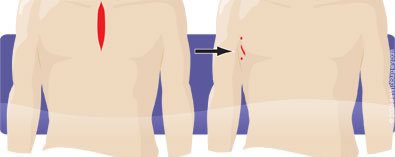Robotic Asissted Coronary Artery Bypass Graft
What is Coronary Artery Disease?
Coronary artery disease – also known as heart disease – is the clogging of arteries within the heart. Over time fats, cholesterol and other substances build up in the walls of arteries to form a type of plaque. When some of the plaque loosens and breaks off, a blood clot forms, and blood flow to the heart is blocked. If left untreated, this could cause heart attack or stroke.
Treatment for Coronary Artery Disease
The treatment options available to a person with coronary artery disease depend on the severity of the condition. Some patients may not require any intervention. Others may be prescribed medications, while others may undergo interventional cardiology treatment, such as stenting and cardiac catheterization.
Coronary Artery Bypass Graft (CABG)
In the most severe cases, surgery is needed to treat heart disease. Coronary artery bypass graft (CABG) – also known as coronary revascularization surgery or heart bypass surgery – is an operation that uses blood vessels to bypass clogged heart arteries.
The goal of CABG is to allow blood to flow to the heart the way it should. Surgeons take a blood vessel from the patient’s chest, leg or arm. One end of the vessel is attached to a healthy artery, and the other end is attached to the diseased coronary artery below the point where it is clogged. This creates a new channel, allowing blood to flow freely again.
Traditional “open heart” surgery involves sternotomy – cutting through the breastbone and opening the ribs. This can cause significant trauma, prolong healing time and increase the risk for serious complications and even mortality.
Robotic-Assisted Coronary Artery Bypass Graft: A Less Invasive Option
 Robotic-assisted coronary artery bypass graft is an alternative to conventional open heart surgery. When performed robotically with the da Vinci Surgical System, the CABG is done with unparalleled precision and control through a few small incisions along the side of the chest.
Robotic-assisted coronary artery bypass graft is an alternative to conventional open heart surgery. When performed robotically with the da Vinci Surgical System, the CABG is done with unparalleled precision and control through a few small incisions along the side of the chest.
Benefits of Robotic-Assisted Coronary Bypass Graft
In addition to avoiding the pain and trauma of sternotomy and rib spreading, this may provide patient benefits such as:
- Less risk of infection
- Less blood loss and need for blood transfusions
- Shorter hospital stay
- Significantly less pain and scarring
- Faster recovery
- Quicker return to normal activities
As with any surgery, these benefits cannot be guaranteed, as surgery is both patient- and procedure-specific. While robotic-assisted CABG is considered safe and effective, it may not be appropriate for every individual. Always ask your doctor about all treatment options, as well as their risks and benefits.
Illustrations courtesy of Intuitive Surgical, Inc.